In a groundbreaking development in the fight against COVID-19, researchers have uncovered a novel strategy to inhibit SARS-CoV-2 infection by targeting the human ACE2 receptor with a specially designed camelid antibody. This innovative approach, described in a recent publication in Nature Communications, has revealed compelling evidence that binding ACE2 directly can effectively block viral entry and provide significant protective effects in animal models. The implications of this discovery could mark a paradigm shift in therapeutic interventions aimed at mitigating the devastating impacts of the ongoing pandemic.
SARS-CoV-2, the virus responsible for COVID-19, exploits the angiotensin-converting enzyme 2 (ACE2) receptor on human cells as its primary gateway for infection. The viral spike protein attaches with high affinity to ACE2, facilitating viral entry and subsequent replication. Consequently, interrupting this interaction has been a critical target for antiviral strategies. Traditional methods have focused extensively on targeting the virus itself—neutralizing antibodies aimed at the spike protein or vaccines eliciting immune responses. However, this new study pivots to the host receptor, ACE2, as a therapeutic target, heralding a novel approach in antiviral defense.
Central to this research is the employment of a camelid-derived antibody that exhibits unique properties making it especially suitable for therapeutic use. Camelid antibodies, derived from species like llamas and alpacas, are characterized by their single-domain structure, known as nanobodies. These nanobodies possess remarkable stability and the capability to bind epitopes that are typically inaccessible to conventional antibodies. This allows for high-affinity binding to protein targets such as ACE2, potentially blocking the virus’s ability to dock and initiate infection.
The team engineered a camelid antibody that selectively binds to the ACE2 receptor, effectively sterically hindering the SARS-CoV-2 spike protein from attaching to the receptor’s binding interface. This interference was meticulously validated through in vitro assays demonstrating a significant reduction of viral binding and entry into cultured human cells expressing ACE2. The scientific rigor and precision in designing this antibody underscores the potential of nanobody-based therapeutics in clinical applications against viral pathogens.
Importantly, the efficacy of the camelid antibody was not limited to cell culture experiments. The authors extended their investigations into robust animal models to assess in vivo protective effects. Administration of the nanobody in a murine model expressing human ACE2 conferred substantial protection against SARS-CoV-2 challenge. Mice treated with the antibody showed markedly diminished viral loads in lung tissues and reduced pathological manifestations compared to untreated controls. These findings are a crucial proof-of-concept demonstrating that targeting the host receptor directly can be both safe and effective.
Furthermore, the antibody’s ability to localize to the respiratory tract—a primary site of viral replication—enhanced its protective capacity. Intranasal delivery of the nanobody enabled direct access to the mucosal surfaces where the virus initiates infection, ensuring high local concentrations and rapid receptor occupancy. This modality presents an attractive advantage for clinical deployment, potentially offering a prophylactic tool that can be easily administered to at-risk populations or healthcare workers.
From a mechanistic standpoint, the study sheds light on the structural dynamics of the ACE2-nanobody interaction. Cryo-electron microscopy data revealed the precise binding epitopes and conformational changes induced by the nanobody, providing a detailed molecular framework that rationalizes the observed functional blockade of SARS-CoV-2 binding. This structural insight is invaluable for guiding further optimization and engineering of receptor-targeting biologics.
The specificity of the camelid antibody towards human ACE2 is a pivotal aspect, minimizing off-target effects and adverse outcomes by avoiding interactions with other proteins. Additionally, the nanobody’s small size and simple structure offer advantages in manufacturability, stability, and tissue penetration, critical factors for therapeutic development. The production scalability of camelid antibodies further adds to their appeal in responding to global health emergencies.
Notably, this research addresses lingering concerns about potential interference with ACE2’s physiological functions. ACE2 is a key enzyme in the renin-angiotensin system, implicated in cardiovascular and pulmonary homeostasis. The antibody’s binding site was carefully selected to circumvent enzymatic inhibition, preserving ACE2’s beneficial roles while blocking viral engagement. This nuanced approach balances antiviral efficacy with safety, a critical consideration often overlooked in receptor-targeted therapies.
The implications of this research extend beyond SARS-CoV-2, as the ACE2 receptor is utilized by multiple coronaviruses and related pathogens. This positions the camelid antibody as a versatile platform for broad-spectrum antiviral strategies, potentially providing cross-protective benefits against future emerging coronaviruses. Such preparedness is paramount in a world where zoonotic spillovers pose ongoing threats to global health security.
Moreover, the study’s findings invite further exploration into combination therapies. By pairing receptor-targeting nanobodies with conventional antibody cocktails or antiviral drugs, synergistic effects could be achieved, enhancing the breadth and durability of antiviral protection. This multimodal approach could be indispensable in combating viral variants exhibiting enhanced immune escape or resistance.
The work also exemplifies the innovative convergence of structural biology, immunology, and virology in rapid therapeutic development. Employing state-of-the-art biophysical techniques alongside rigorous in vivo experiments accelerated the translation of molecular insights into tangible therapeutic candidates. This integrated framework serves as a model for addressing future infectious disease challenges with unprecedented speed and precision.
As the COVID-19 pandemic persists with new variants emerging, the need for alternative therapeutics remains acute. The camelid antibody targeting ACE2 adds a potent weapon to the antiviral arsenal, complementing vaccines and antiviral drugs. Its promise lies not only in treatment but also in potential prophylaxis, particularly for individuals with compromised immunity who may not respond adequately to vaccination.
Looking ahead, clinical trials will be critical to ascertain the safety, pharmacokinetics, and efficacy of this nanobody in humans. The encouraging preclinical data pave the way for such translational efforts, fueling hope for an additional layer of protection against SARS-CoV-2. With further refinement and validation, this strategy could revolutionize how receptor-targeted interventions are deployed against respiratory viruses.
In conclusion, the study by Blachier and colleagues offers a compelling new avenue for COVID-19 intervention by harnessing camelid antibodies to block ACE2-mediated viral entry. Their innovative approach not only impedes the virus effectively but protects the host without compromising essential physiological functions. As the world continues to grapple with SARS-CoV-2, this research marks a significant milestone towards durable and broad-spectrum antiviral therapeutics grounded in cutting-edge molecular engineering.
Subject of Research: Targeting the human ACE2 receptor to inhibit SARS-CoV-2 viral binding using a camelid-derived nanobody antibody, and evaluating its protective efficacy in vivo.
Article Title: Targeting ACE2 with a camelid antibody inhibits SARS-CoV-2 binding and has protective effects in vivo.
Article References:
Blachier, S., Vaney, MC., Conquet, L. et al. Targeting ACE2 with a camelid antibody inhibits SARS-CoV-2 binding and has protective effects in vivo. Nat Commun 16, 10268 (2025). https://doi.org/10.1038/s41467-025-65144-w
Image Credits: AI Generated
DOI: https://doi.org/10.1038/s41467-025-65144-w
Tags: animal models in virus researchantiviral strategies against COVID-19blocking ACE2 receptorcamelid antibody therapyinnovative COVID-19 treatmentsNature Communications publicationparadigm shift in COVID-19 therapiesSARS-CoV-2 infection preventionspike protein and ACE2 interactiontherapeutic interventions for pandemicunique properties of camelid antibodiesviral entry inhibition mechanisms




